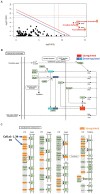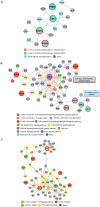Integrative Analysis Reveals Common and Unique Roles of Tetraspanins in Fibrosis and Emphysema
- PMID: 33424923
- PMCID: PMC7793877
- DOI: 10.3389/fgene.2020.585998
Integrative Analysis Reveals Common and Unique Roles of Tetraspanins in Fibrosis and Emphysema
Abstract
While both chronic obstructive pulmonary disease (COPD) and idiopathic pulmonary fibrosis (IPF) are multifactorial disorders characterized by distinct clinical and pathological features, their commonalities and differences have not been fully elucidated. We sought to investigate the preventive roles of tetraspanins Cd151 and Cd9 -that are involved in diverse cellular processes in lung pathophysiology- in pulmonary fibrosis and emphysema, respectively, and to obtain a deeper understanding of their underlying molecular mechanisms toward facilitating improved therapeutic outcomes. Using an integrative approach, we examined the transcriptomic changes in the lungs of Cd151- and Cd9-deficient mice using functional-enrichment-analysis, pathway-perturbation-analysis and protein-protein-interaction (PPI) network analysis. Circadian-rhythm, extracellular-matrix (ECM), cell-adhesion and inflammatory responses and associated factors were prominently influenced by Cd151-deletion. Conversely, cellular-junctions, focal-adhesion, vascular-remodeling, and TNF-signaling were deeply impacted by Cd9-deletion. We also highlighted a "common core" of factors and signaling cascades that underlie the functions of both Cd151 and Cd9 in lung pathology. Circadian dysregulation following Cd151-deletion seemingly facilitated progressive fibrotic lung phenotype. Conversely, TGF-β signaling attenuation and TNF-signaling activation emerged as potentially novel functionaries of Cd9-deletion-induced emphysema. Our findings offer promising avenues for developing novel therapeutic treatments for pulmonary fibrosis and emphysema.
Keywords: COPD; IPF; biomarker discovery; cellular networks; disease biology; integrative gene expression analysis; signaling pathways; systems biology; tetraspanins.
Copyright © 2020 Tripathi, Itoh, Takeda, Tsujino, Kondo, Kumanogoh and Mizuguchi.
Conflict of interest statement
YK was employed by the company Sumitomo Dainippon Pharma Co., Ltd. The remaining authors declare that the research was conducted in the absence of any commercial or financial relationships that could be construed as a potential conflict of interest.
Figures





Similar articles
-
Tetraspanin CD151 protects against pulmonary fibrosis by maintaining epithelial integrity.Am J Respir Crit Care Med. 2012 Jul 15;186(2):170-80. doi: 10.1164/rccm.201201-0117OC. Epub 2012 May 16. Am J Respir Crit Care Med. 2012. PMID: 22592804 Free PMC article.
-
Integrated Genomics Reveals Convergent Transcriptomic Networks Underlying Chronic Obstructive Pulmonary Disease and Idiopathic Pulmonary Fibrosis.Am J Respir Crit Care Med. 2016 Oct 15;194(8):948-960. doi: 10.1164/rccm.201510-2026OC. Am J Respir Crit Care Med. 2016. PMID: 27104832 Free PMC article.
-
Role of tetraspanins CD9 and CD151 in primary melanocyte motility.J Invest Dermatol. 2005 Nov;125(5):1001-9. doi: 10.1111/j.0022-202X.2005.23882.x. J Invest Dermatol. 2005. PMID: 16297202
-
Preventive Role of Tetraspanin CD9 in Systemic Inflammation of Chronic Obstructive Pulmonary Disease.Am J Respir Cell Mol Biol. 2015 Dec;53(6):751-60. doi: 10.1165/rcmb.2015-0122TR. Am J Respir Cell Mol Biol. 2015. PMID: 26378766 Review.
-
Distinct Roles of Wnt/β-Catenin Signaling in the Pathogenesis of Chronic Obstructive Pulmonary Disease and Idiopathic Pulmonary Fibrosis.Mediators Inflamm. 2017;2017:3520581. doi: 10.1155/2017/3520581. Epub 2017 May 9. Mediators Inflamm. 2017. PMID: 28588349 Free PMC article. Review.
Cited by
-
Repeated exposure to eucalyptus wood smoke alters pulmonary gene and metabolic profiles in male Long-Evans rats.Toxicol Sci. 2024 May 28;199(2):332-348. doi: 10.1093/toxsci/kfae040. Toxicol Sci. 2024. PMID: 38544285 Free PMC article.
-
Current Perspective on the Role of the Circadian Clock and Extracellular Matrix in Chronic Lung Diseases.Int J Environ Res Public Health. 2023 Jan 30;20(3):2455. doi: 10.3390/ijerph20032455. Int J Environ Res Public Health. 2023. PMID: 36767821 Free PMC article. Review.
-
Proteomic Analysis Reveals Differential Expression Profiles in Idiopathic Pulmonary Fibrosis Cell Lines.Int J Mol Sci. 2022 May 1;23(9):5032. doi: 10.3390/ijms23095032. Int J Mol Sci. 2022. PMID: 35563422 Free PMC article.
References
-
- Brightling C. E. (2013). Biomarkers that predict and guide therapy for exacerbations of chronic obstructive pulmonary disease. Ann. Am. Thoracic Soc. 10(Suppl.), S214–S219. - PubMed
LinkOut - more resources
Full Text Sources
Molecular Biology Databases

